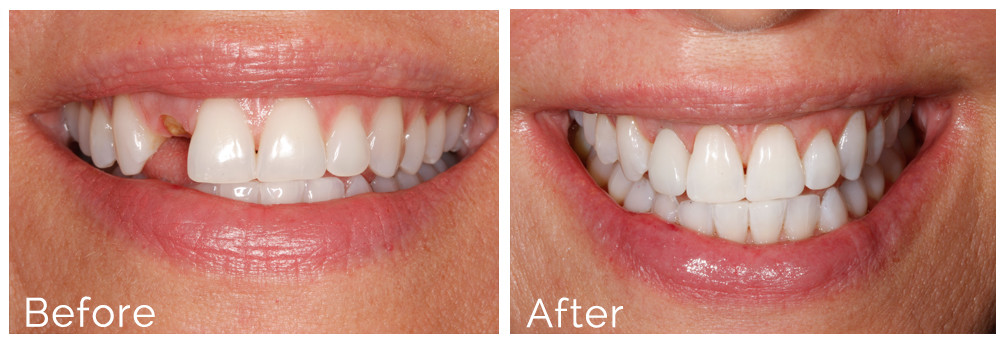Not known Facts About Dental Sense
Not known Facts About Dental Sense
Blog Article
The Basic Principles Of Dental Sense
Table of ContentsDental Sense Can Be Fun For EveryoneThe Only Guide to Dental SenseRumored Buzz on Dental SenseDental Sense - Truths
are medical gadgets surgically dental implanted into the jaw to recover an individual's ability to chew or their look. They give assistance for fabricated (fake) teeth, such as crowns, bridges, or dentures. When a tooth is lost because of injury or disease, a person can experience complications such as quick bone loss, malfunctioning speech, or adjustments to chewing patterns that cause pain.Oral dental implant systems are composed of an oral implant body and oral implant abutment and may additionally consist of a joint addiction screw. Dental implants. The dental implant body is surgically placed in the jawbone instead of the tooth's origin. The dental implant joint is typically connected to the dental implant body by the abutment fixation screw and expands via gum tissues right into the mouth to support the connected artificial teeth
(https://www.mixcloud.com/dentalsense1/)Framework of The Oral Implant System selecting oral implants, talk to your dental copyright about the prospective advantages and dangers, and whether you are a candidate for the treatment. Things to think about: Your overall health is a vital aspect in determining whether you are a great prospect for oral implants, exactly how long it will take to heal, and how much time the dental implant may stay in location.
Smoking might impact the recovery procedure and decrease the lasting success of the implant. The healing procedure for the implant body may take several months or longer, throughout which time you typically have a temporary joint in location of the tooth. the dental implant treatment: Thoroughly follow the dental health instructions provided to you by your oral company.
Some Known Factual Statements About Dental Sense
Implant failing can result in the requirement for one more surgery to fix or change the implant system. Recovers the ability to chew Brings back aesthetic appearance Assists keep the jawbone from diminishing because of bone loss Protects the health and wellness of the surrounding bone and gums Assists maintain adjacent (close-by) teeth stable Boosts lifestyle Damage to bordering all-natural teeth during implant placement Injury to the surrounding cells during surgical treatment, such as sinus opening Injury during surgical treatment (for example, crack of surrounding jawbone) Insufficient feature, such as feeling like the teeth do not attack with each other typically A feeling that the tooth is loosened or turning in area arising from a joint screw loosening up Implant body failure (looseness of the implant body) as a result of systemic infection, which might be most likely in clients with unchecked diabetes mellitus due to local infection in bone and gums sustaining the dental implant body as a result of postponed healing, which may be more probable in clients who smoke Problem cleaning the gum tissues around the dental implant, resulting in bad oral hygiene Without treatment periodontal condition Post-surgical pins and needles because of nerve impingement or damage Constantly notify wellness treatment providers and imaging specialists that you have dental implants before any kind of magnetic vibration imaging (MRI) or x-ray procedures.
FDA is not familiar with any damaging events reported for MRI or x-ray procedures with dental implants. Dental implants systems are normally made of materials that adhere to international agreement standards of the International Organization for Standardization (ISO) or ASTM International. These criteria have information of what makes a secure material.

An oral implant is a structure that replaces a missing out on tooth. With screw-like gadgets, the specialist inserts a dental implant into the jawbone, and it functions as an anchor for an artificial tooth, called a crown. A gadget called a joint connects the artificial tooth to the dental implant. The crown is customized to fit the individual's mouth and match the shade of their teeth.
Not known Facts About Dental Sense
Some individuals are not eligible for oral implant surgical treatment. It the original source is for oral cosmetic surgeons to operate individuals with: acute illnessuncontrollable metabolic diseasebone or soft cells disease or infectionIf these issues are settled, an individual can have the surgical treatment. In, oral doctors avoid from operating on individuals with: If people with any of the above undergo oral implant surgical procedure, there is a greater threat of the dental implant stopping working.

Oral implant surgical treatment is an individualized procedure. It's not the exact same for every person. The adhering to offers a general introduction of what you can anticipate your dental practitioner, oral doctor, periodontist or prosthodontist to do: Put the dental implant surgically. Give you time to recover. Affix the message and final crown, bridge or denture.
Next off, your specialist will meticulously place the oral implant right into your jaw. If your dental implant is near the front of your mouth, your dental expert will certainly make a temporary tooth for you to wear up until you recover.
Some Known Facts About Dental Sense.
Your copyright can inform you what to anticipate in your scenario. Throughout the recovery phase, your jawbone should fuse to the oral implant. This process, called osseointegration, is vital for security and long-term success. This procedure can take anywhere from three to 9 months. Sometimes, it might take longer.
As soon as your implant heals, your dental professional can affix the abutment (little port blog post) and your last restoration (crown, bridge or denture). This usually takes regarding one hour to finish and might require a 2nd minor surgery. You shouldn't feel any kind of pain throughout your dental implant treatment since your provider will utilize medicine to numb your gum tissues.
Report this page